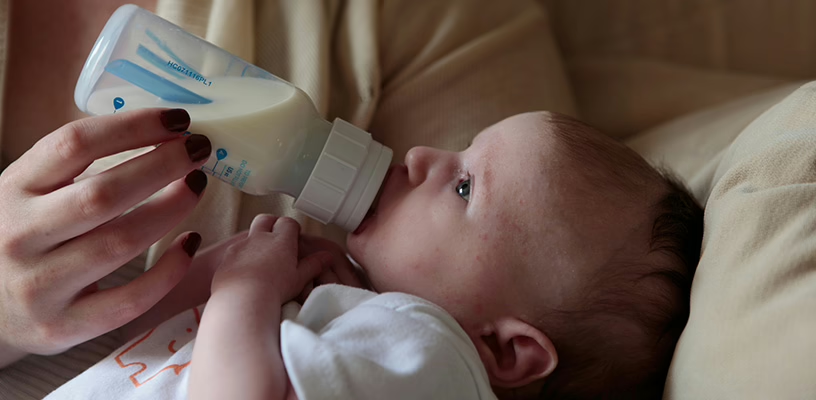Everything You Need to Know About Safely Storing Your Baby’s Milk
Many moms need to pump breast milk, which also means storing it. Whether you're exploring pumping because you’re returning to work, need extra flexibility, or want to build up your milk supply, knowing how to safely keep that nectar of yours is very important.

- Room temperature storage: the four-hour rule
- How to choose the right breast milk storage containers
- How to store breast milk in the refrigerator
- How to store breast milk in the freezer
- How to warm breast milk for feeding
- How to tell if your breast milk has spoiled
- Storing breast milk for premature or hospitalized infants
- Final thoughts
The longer breast milk is stored, whether in the fridge or freezer, the more nutrients it loses. 1 What’s more, if you don’t store it correctly, it will spoil, just like most food.
Correctly storing your breast milk will save you from wasting it (a big deal, given that you probably spent hours pumping it), and also ensure that your little one gets all the nutrition he needs. Let’s take an in-depth look at how to store your breast milk safely.
Room temperature storage: the four-hour rule
After pumping your breast milk, time is of the essence. Breast milk can safely stay at room temperature for up to 4 hours. 2
You need to be careful about where you store the milk so it doesn’t spoil or lose nutrients. Be sure the room isn’t too warm, aiming for a temperature no higher than 77 degrees Fahrenheit, and avoid placing your milk in direct sunlight or near other heat sources. 2
The “rule of fours”
A simple way to remember the time limits on pumped milk is the “rule of fours”: 2
- Up to 4 hours at room temperature
- Up to 4 days in the refrigerator
Note that, while four hours is the recommended maximum for leaving out breast milk, it’s not ideal to leave it that long. It’s best to refrigerate or freeze milk as soon as possible to keep bacteria growth at bay.
If you’re pumping on the go, you can keep freshly expressed milk for up to 24 hours in an insulated cooler on ice (or ice packs) before refrigerating or freezing it. 2
How to choose the right breast milk storage containers
As well as maintaining the right temperature, it’s important to choose suitable storage containers. Always make sure they’re clean and dry before filling them, and use the guidelines below to pick the right ones:
- Glass or hard plastic: Opt for hard, BPA-free plastic or sterile glass containers with tight-fitting lids to prevent spills. Avoid plastic containers with recycling numbers three or seven, as they may contain BPA. 3
- Size matters: Store milk in small, 2- to 4-ounce batches to avoid wasting any. 3 If you’re freezing your milk, choose containers that can hold this amount without filling them to the top since breast milk expands when frozen.
- Try storage bags: You can use special plastic bags designed for breast milk to save space in your freezer. These bags are thicker than regular food-storage bags with better seals, and they don’t contain BPA or other harmful chemicals. 4
Don’t use disposable bottle liners or thin plastic bags that aren’t explicitly designed for breast milk storage since they can easily leak or spill.
Breastfeeding supplies can be tax-deductible
Breast pumps and supplies like storage containers can be tax-deductible, and your insurance policy may cover the costs. Be sure to check which supplies are covered before purchasing anything. 3
How to store breast milk in the refrigerator
If you’re not going to use pumped breast milk immediately, you should refrigerate it. Again, you can store freshly pumped breast milk in the refrigerator for up to four days, but it’s best to use it within 24–72 hours to ensure your baby gets the most nutrients, even if it’s technically safe for longer. 5
Here are a few more tips on how to safely store your breast milk in the fridge:
- Location: Always put pumped milk in the back center of your refrigerator, where the temperature is the coldest and most consistent. 3 Don’t store breast milk in the fridge door because the temperature fluctuates every time it’s opened.
- Container placement: If you’re using breast milk storage bags, try placing them in a food storage container to keep them upright and away from raw foods that could contaminate your milk.
How to store breast milk in the freezer
If you want to keep breast milk for longer than four days (whether because you’re building up a supply or have excess from power pumping), you have to freeze it. Here’s what to consider when freezing your breast milk:
- Timing: You can store breast milk in the freezer for up to 12 months, but it’s best to use it within 6 months for optimal quality. 6
- Freezer type: Your freezer should have a separate door from the fridge to ensure a consistent temperature of 0°F (-18°C) or lower. 6
- Container type: Use freezer-safe containers like those described above—glass jars with screw caps, hard plastic containers with snap tops, or breast milk storage bags. Leave an inch or so of space at the top of the container to allow for expansion as the milk freezes.
- Labeling: Always label each container with the date you expressed the milk. As your baby grows, his nutritional needs will change, and your breast milk’s composition will adapt, so use the oldest milk first. 7
- Location: Don’t place milk in the freezer door. Instead, store it in the back center of your freezer, where the temperature is coldest and most consistent.
How to thaw frozen breast milk
You should thaw frozen breast milk in the refrigerator overnight to retain the most nutrients possible. 8 To thaw it more quickly, place your frozen breast milk container under warm, running water or in a bowl filled with warm (never hot) water.
Once it’s thawed, you can keep breast milk in the fridge for up to 24 hours, but don’t refreeze it. Discard any leftover milk after that 24-hour window passes. 6 Use thawed milk left out at room temperature within 2 hours. 9
Never thaw breast milk in the microwave. This process can create hot spots that could be harmful to your baby. It can also destroy some of the nutrients and antibodies in the milk. 10
You shouldn’t heat breast milk on the stovetop unless you’re scalding the milk for high lipase issues, which we’ll explain in detail below.
How to warm breast milk for feeding
When it’s time to feed your baby, gently warm your refrigerated breast milk so it retains its proper nutrient balance. 8 You can serve breast milk cold from the fridge, but if your baby prefers warm milk, here’s the right way to warm it up:
- Warm water: As with thawing frozen milk, you can place the bottle or bag in warm water (either running water or a bowl). Avoid hot water. Swirl the milk to help it warm evenly.
- Bottle warmer: If that sounds like too much of a pain, you can also just get a bottle warmer to easily and safely warm breast milk.
Before feeding your baby, test the temperature by putting a drop of milk on the inside of your wrist. It should feel warm, but not burning hot.
How to mix fresh and refrigerated milk
Freshly pumped breast milk is always the best choice for your baby, but if you need to combine milk pumped during different sessions (e.g., if you don’t have time to pump enough milk for a full feeding), that’s OK.
However, you should avoid adding fresh, warm breast milk to refrigerated or frozen milk. This can cause the old milk to warm up too much and spoil. Instead, put your freshly expressed milk in the refrigerator for a few hours before adding it to the older batch. 10
When you combine milk, label the container with the date of the oldest milk, not the newest.
What about leftovers?
If your baby doesn’t finish a bottle, use the remaining milk within 2 hours or discard it. If you refrigerate it immediately, you can use it for the very next feeding, but only once, as rewarming multiple times increases the risk of bacterial growth. 6
How to tell if your breast milk has spoiled
Even if you do your best to safely store your milk, it may sometimes go bad.
Before feeding your baby, look at your breast milk. Fresh milk separates into layers (with the fat rising to the top), but it should mix easily with a gentle swirl. If you notice chunks or a stringy, mucus-like consistency, it’s probably spoiled.
You can also smell or taste the milk yourself to see if it’s gone bad. Spoiled breast milk will smell and taste sour, like bad cow’s milk. Discard any spoiled breast milk immediately.
Lipase activity
Complicating things, high levels of lipase—an enzyme that helps babies digest fats—can cause your milk to smell sour or soapy, even if it hasn’t gone bad. 11 While it won’t harm your baby if he drinks it, he might refuse your breast milk because of the smell.
Scalding freshly pumped milk can help reduce lipase activity and make it more palatable for your baby. To safely scald your breast milk:
- Heat it on the stove to 144°F (62°C) for one minute (do not boil)
- Cool it quickly in ice water before storing it in the fridge
- Reheat scalded milk as usual before feeding your baby
Scalded breast milk may have a slightly altered nutritional profile, so take extra care with storing it. You don’t have to do anything special—just be sure you’re following the guidelines. 12
Storing breast milk for premature or hospitalized infants
You’ll need to be stricter with storage if your baby is premature, hospitalized, or has a weaker immune system. 9 Here’s what you need to know:
- Time limits: Use freshly pumped milk within one hour or place it in the refrigerator within the same time frame.
- Labeling: Include your baby’s name, the date, and the time you pumped. You should also add any medications you’ve taken on the label.
- Thawed milk: If you thaw milk in the fridge, use it within 24 hours. Once warmed, use it within two hours.
Check in with your baby’s pediatrician or lactation consultant if you have any questions about pumping and storing breast milk for your baby during this time.
Final thoughts
Pumping and storing breast milk might feel overwhelming at first, but at its heart, it isn’t all that complicated, and you’ll settle into a routine easily enough. By following the guidelines in this article, you’ll ensure your baby gets all the nutrition he needs and avoid wasting any of your precious liquid gold.
Remember, you can always reach out to your doctor or lactation consultant if you have any more questions about pumping and storing your milk. So pump away—you and your baby will appreciate having a fully stocked refrigerator!
Article Sources
- Florida Department of Health in Pinellas. "ABM Clinical Protocol #8: Human Milk Storage Information for Home Use for Full-Term Infants, Revised 2017" Retrieved May 23, 2025.
- Centers for Disease Control and Prevention. "Breast Milk Storage and Preparation" Retrieved May 23, 2025.
- Office on Women's Health. "Pumping and storing breastmilk" Retrieved May 23, 2025.
- Center for Environmental Health. "Is it Ok to Store, Freeze, and Defrost Breast Milk in Plastic?" Retrieved May 23, 2025.
- Centers for Disease Control and Prevention. "Storage and Preparation of Breast Milk" Retrieved May 23, 2025.
- WIC Breastfeeding Support. "Storing and Thawing Breast Milk" Retrieved May 23, 2025.
- University of Rochester Medical Center. "Thawing Breastmilk" Retrieved May 23, 2025.
- Maine Center for Disease Control & Prevention. "Storing Breast Milk " Retrieved May 23, 2025.
- University of Rochester Medical Center. "Breastmilk: Pumping, Collecting, Storing" Retrieved May 23, 2025.
- WIC and Nutrition Services. "Proper Storage and Handling of Breast Milk" Retrieved May 23, 2025.
- Pueblo County, Colorado. "Breastfeeding in Child Care Toolkit" Retrieved May 23, 2025.
- Pediatric Clinics of North America. "Human Milk Composition: Nutrients and Bioactive Factors" Retrieved May 23, 2025.







